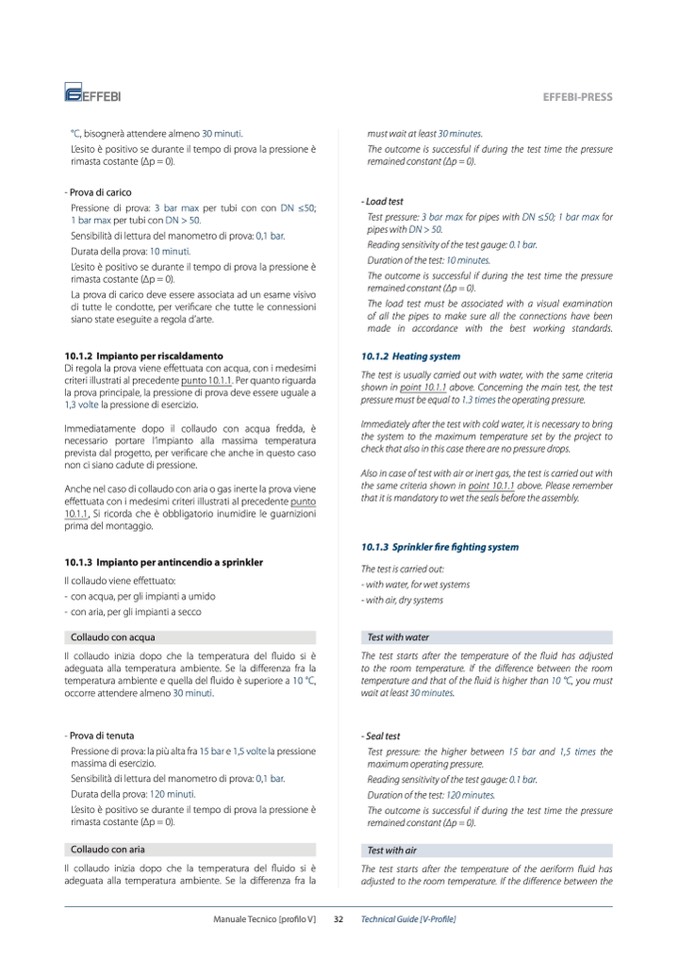
°C, bisognerà attendere almeno 30 minuti.
L’esito è positivo se durante il tempo di prova la pressione è
rimasta costante (Δp = 0).
- Prova di carico
Pressione di prova: 3 bar max per tubi con con DN ≤50;
1 bar max per tubi con DN > 50.
Sensibilità di lettura del manometro di prova: 0,1 bar.
Durata della prova: 10 minuti.
L’esito è positivo se durante il tempo di prova la pressione è
rimasta costante (Δp = 0).
La prova di carico deve essere associata ad un esame visivo
di tutte le condotte, per verificare che tutte le connessioni
siano state eseguite a regola d’arte.
10.1.2 Impianto per riscaldamento
Di regola la prova viene effettuata con acqua, con i medesimi
criteri illustrati al precedente punto 10.1.1. Per quanto riguarda
la prova principale, la pressione di prova deve essere uguale a
1,3 volte la pressione di esercizio.
Immediatamente dopo il collaudo con acqua fredda, è
necessario portare l’impianto alla massima temperatura
prevista dal progetto, per verificare che anche in questo caso
non ci siano cadute di pressione.
Anche nel caso di collaudo con aria o gas inerte la prova viene
effettuata con i medesimi criteri illustrati al precedente punto
10.1.1. Si ricorda che è obbligatorio inumidire le guarnizioni
prima del montaggio.
10.1.3 Impianto per antincendio a sprinkler
Il collaudo viene effettuato:
- con acqua, per gli impianti a umido
- con aria, per gli impianti a secco
Collaudo con acqua
Il collaudo inizia dopo che la temperatura del fluido si è
adeguata alla temperatura ambiente. Se la differenza fra la
temperatura ambiente e quella del fluido è superiore a 10 °C,
occorre attendere almeno 30 minuti.
- Prova di tenuta
Pressione di prova: la più alta fra 15 bar e 1,5 volte la pressione
massima di esercizio.
Sensibilità di lettura del manometro di prova: 0,1 bar.
Durata della prova: 120 minuti.
L’esito è positivo se durante il tempo di prova la pressione è
rimasta costante (Δp = 0).
Collaudo con aria
Il collaudo inizia dopo che la temperatura del fluido si è
adeguata alla temperatura ambiente. Se la differenza fra la
EFFEBI-PRESS
must wait at least 30 minutes.
The outcome is successful if during the test time the pressure
remained constant (Δp = 0).
- Load test
Test pressure: 3 bar max for pipes with DN ≤50; 1 bar max for
pipes with DN > 50.
Reading sensitivity of the test gauge: 0.1 bar.
Duration of the test: 10 minutes.
The outcome is successful if during the test time the pressure
remained constant (Δp = 0).
The load test must be associated with a visual examination
of all the pipes to make sure all the connections have been
made in accordance with the best working standards.
10.1.2 Heating system
The test is usually carried out with water, with the same criteria
shown in point 10.1.1 above. Concerning the main test, the test
pressure must be equal to 1.3 times the operating pressure.
Immediately after the test with cold water, it is necessary to bring
the system to the maximum temperature set by the project to
check that also in this case there are no pressure drops.
Also in case of test with air or inert gas, the test is carried out with
the same criteria shown in point 10.1.1 above. Please remember
that it is mandatory to wet the seals before the assembly.
10.1.3 Sprinkler fire fighting system
The test is carried out:
- with water, for wet systems
- with air, dry systems
Test with water
The test starts after the temperature of the fluid has adjusted
to the room temperature. If the difference between the room
temperature and that of the fluid is higher than 10 °C, you must
wait at least 30 minutes.
- Seal test
Test pressure: the higher between 15 bar and 1,5 times the
maximum operating pressure.
Reading sensitivity of the test gauge: 0.1 bar.
Duration of the test: 120 minutes.
The outcome is successful if during the test time the pressure
remained constant (Δp = 0).
Test with air
The test starts after the temperature of the aeriform fluid has
adjusted to the room temperature. If the difference between the
Manuale Tecnico [profilo V]
32
Technical Guide [V-Profile]

